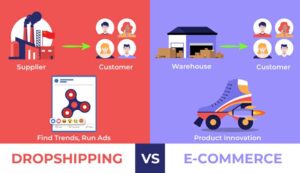Entrepreneurs and aspiring business owners are constantly seeking the perfect formula for success. Two of the most popular business models, e-commerce and dropshipping, have been vying for attention, each with their own set of advantages and disadvantages. E-commerce, with its traditional storefront approach, offers control and customization, while dropshipping, with its lean and agile methodology, promises flexibility and scalability. But which one is right for you? As the lines between these two models continue to blur, it’s essential to understand the intricacies of each, from inventory management to customer service, to make an informed decision. In this post, we’ll dig into the pros and cons of e-commerce and dropshipping, providing you with a comprehensive guide to help you choose the business model that best fits your goals, resources, and entrepreneurial spirit.
Understanding the models

E-commerce, in its simplest form, refers to the process of buying and selling products or services over the internet. This traditional model involves setting up an online store, sourcing products from suppliers or manufacturers, storing them in a warehouse, and then shipping them directly to customers. As an e-commerce business owner, you’re responsible for managing inventory, handling logistics, and providing customer service.
Dropshipping you don’t hold any inventory. Instead, you partner with a supplier who ships products directly to your customers on your behalf. You focus on marketing and selling the products, while the supplier takes care of the storage, packaging, and shipping. This model eliminates the need for upfront inventory costs and allows for greater flexibility and scalability.
Choosing the right fit
Ecommerce: Ideal for those who want complete control over branding, customer experience, and product offerings. It’s suitable for businesses with the resources to manage inventory and logistics.
Dropshipping: Perfect for those seeking a low-risk, scalable way to test the e-commerce waters. It suits businesses with limited resources or those wanting to experiment with different products before significant investment.
Key differences between E-commerce and Dropshipping
Inventory management: Ecommerce requires upfront investment and managing inventory, while dropshipping eliminates these needs.
Shipping and fulfillment: Ecommerce involves storing and shipping products yourself, while dropshipping relies on suppliers for fulfillment.
Marketing and advertising: Ecommerce strategies focus on building a brand identity, while dropshipping prioritizes performance-driven marketing for conversions.
Pricing and profit margins: Ecommerce offers more control over pricing and potentially higher margins due to bulk purchasing. Dropshipping has limited control over pricing and typically lower margins due to wholesale costs.
Scalability and Growth: Ecommerce requires investment in inventory and logistics for scaling. Dropshipping allows for quick scaling by adjusting marketing efforts or product offerings.
E-commerce and Dropshipping challenges and pitfalls
Ecommerce: Inventory management can be a hurdle, leading to overstocking or understocking. Additionally, logistics and shipping complexities can arise.
Dropshipping: Lack of control over the supply chain can impact product quality, shipping times, and customer service. Thin profit margins and reliance on suppliers for inventory management are also challenges.
Case studies: Real-life examples of E-commerce and Dropshipping success
To further illustrate the differences between e-commerce and dropshipping, let’s take a look at some real-life examples of businesses that have found success with each model. These case studies will give you a glimpse into the inner workings of companies that have thrived in the e-commerce and dropshipping spaces.
On the e-commerce side, we have companies like Warby Parker, a fashion brand that has disrupted the traditional eyeglasses industry by offering stylish, affordable glasses online. Warby Parker holds its own inventory, allowing for complete control over the customer experience and fulfillment process. This approach has paid off, with the company reportedly valued at over $1.5 billion.
On the dropshipping side, we have companies like Irwin Dominguez, a entrepreneur who built a successful dropshipping business selling phone cases and accessories. By leveraging the power of social media and influencer marketing, Irwin was able to build a brand that generates over $1 million in annual revenue, all without holding any inventory.
These case studies demonstrate that both e-commerce and dropshipping can be viable business models, but the key to success lies in understanding your target market, choosing the right products, and executing a solid marketing and fulfillment strategy. By studying these examples and understanding the pros and cons of each model, you can make an informed decision about which path is right for your business.
Conclusion
Ecommerce and dropshipping each have their strengths and weaknesses. The key is understanding your business goals, target audience, and resources. By carefully evaluating each model, you can make an informed decision aligned with your entrepreneurial vision. There’s no one-size-fits-all approach. Assess your strengths, weaknesses, and market conditions to choose the best model for you. Consider your risk tolerance for inventory management, logistics, and marketing investment. With the right choice, you can focus on growing your business, increasing revenue, and building a loyal customer base. So, research, analyze, and trust your instincts to find the perfect business model for e-commerce success.

